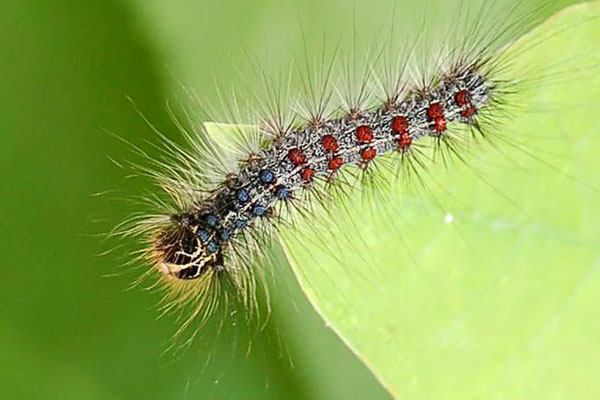Gypsy Moths
The gypsy moth is an invasive species from France that was introduced to the United States in 1869. The plan was to breed them with silkworms and set up a silk industry in the country. However, breeding did not work, and once some gypsy moths escaped, a population was soon established. While in its caterpillar stage, the gypsy moth has the potential to cause defoliation of a wide variety of trees.
What Does It Look Like?

From early spring - mid-June, gypsy moths hatch from egg masses, which are laid during the previous summer. These egg masses are typically tan or light brown in color, but they can turn white if exposed to direct sunlight. Most of the egg masses are located high up on tree branches or under tree bark scales. The size of an egg mass ranges from a quarter-size to as large as a fifty cent piece.
As a caterpillar, the gypsy moth looks similar to the common tent caterpillar; however, the main difference in appearance is that gypsy moth caterpillars have both blue and red spots along their back. Older gypsy moth caterpillars commonly have five pairs of blue spots and six pairs of red spots. The caterpillars also have large, dark eyespots on the front of their head.
There are some differences between adult male and female gypsy moths. Males are mostly brown in color, and female moths are white with brown markings. Females are about three times as large as males, but males have feather-like antennae.
Key facts for identification:
- Egg masses look like brown fuzzy patches
- The masses stay dormant from summer through winter
- Gypsy moth caterpillars reach around two inches in length
- Female gypsy moths do not fly
How Is It Harmful?
The early caterpillar stage is when the gypsy moth causes the most damage. Before they enter a cocoon, gypsy moth caterpillars feast for roughly seven weeks on oak, maple, birch, and many other types of trees. The caterpillars eat new leaves, and as they grow, they eat older leaves as well.
During times when the gypsy moth population is high, the caterpillars can damage thousands of acres of trees. Although deciduous trees can survive 2-3 years of successive defoliation, the lasting effects reduce the resistance of the trees to pests and diseases. When caterpillars eat evergreen tree leaves, the effects are more severe because evergreens don't regrow leaves as easily as deciduous trees.
After the gypsy moth caterpillars enter and hatch from a cocoon, adult gypsy moths have a short life span of about a week. From mid-July - August, the adult female moths attract males using a pheromone, mate, and then lay their egg masses (600-700 eggs). The adult moths die soon after, but the egg masses remain until the following spring.
How to Handle Them?
There are a few ways to address this invasive species:
The first is to destroy the egg masses if you can reach them. If you can knock them off a tree and get them in soapy water, the egg masses will be destroyed.
Gypsy moth insecticides are capable of eliminating gypsy moth caterpillars if a large concentration of them is found. Spraying is most effective against younger caterpillars, but you should always be aware of the side effects of an insecticide. Spraying is not effective against egg masses or gypsy moth pupae.
The greatest predator to the gypsy moth is a fungus named entomophaga maimaiga. Its spores can cause infection in gypsy moths and reduce the overall population. The fungus grows during periods of wet weather, so during periods of hot and dry weather, the gypsy moth population lacks a natural predator and grows quickly.
If you think there is a large infestation of gypsy moths near you, then you should attempt to remove them if possible, and fill out the Department of Environmental Conservation's egg sampling survey and send in your report.
« Return to Invasives & Harmful Plants Guide
Sources:
http://www.dec.ny.gov/animals/83118.html
http://agr.wa.gov/plantsinsects/insectpests/gypsymoth/gm101/identification.aspx
Photo Courtesy of the Department of Environmental Conservation